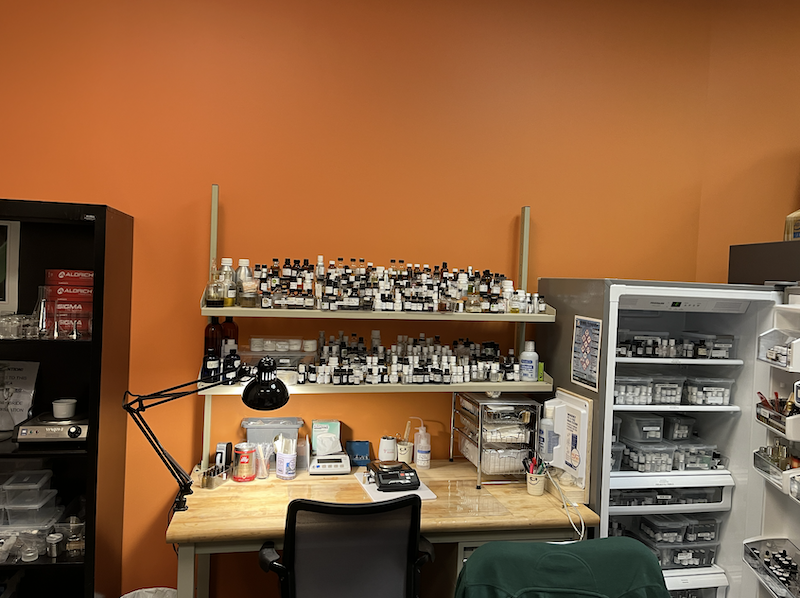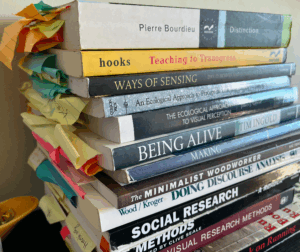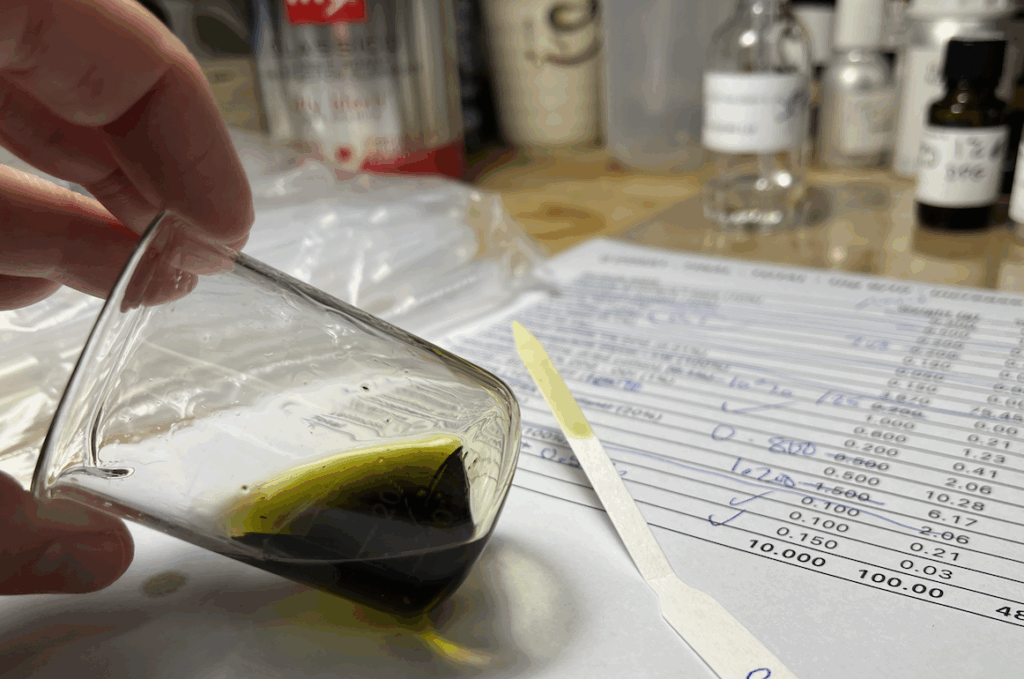
Aroma lab workbench, glassware cabinet, and materials fridge.
In addition to my work as a researcher, I create non-commercial multimodal objects for learning, teaching, and knowledge mobilization, with a focus on the missing modality of aroma. As an educator and researcher who studies informal learning in communities of applied practice (in contrast with institutional Education), my work in this medium reflects a pedagogical, rather than commercial, orientation to aroma (not functional olfaction), as a missing modality of learning and communicating that extends my current and more broad-based research of the material and tacit contingencies of learning, communicating, and making across domains of practice.
For this reason I refer to myself as a researcher-practitioner, rather than perfumer (as I do not manufacture conventional fragrance products) or ‘olfactory artist,’ which reinforces a sensory paradigm rather than calling attention to materials in practice (e.g., ‘wood’ worker, etc). ancillary to my research that attends to the specific properties and affordances of the materials required to learn and do things with a modality that is more or less available to all of us, contrary to the territorial claims and legitimacy games of dominant disciplinary, aesthetic/cultural, and industry authorities, each vying for context control (McBride, 2018).
A focus on materials in practice
My intentional use of the word aroma (rather than smell) is somewhat ‘extra’ disciplinary in terms of my interest in the material basis of odours (i.e., source, provenance, properties, characteristics, etc) rather than their particular status within a specific scientific (i.e., chemistry, psychology, etc), artistic (i.e., olfactory art), or commercial (i.e., fragrance) discourse. In contrast with functional/sensory paradigms of smell, I am interested in the physical and material stuff on the other side of the nose and the competences, skills, knowledge, and very material contingencies that are required to access, learn about, and communicate with and through that stuff (i.e., time, labour, money, and so forth) in applied practice rather than their physiological, affective, or subjective effects.
My concern with the material basis of aroma reflects my primary focus on the the highly tangible affordances of aromatic (and other) materials, environments as modal resources for literacy, learning, and communication (e.g., sound is a modality; whereas hearing is a sensory process). This also reflects the distinction between understanding and learning with and through materials at the site of learning and making rather than consumption or sensory ‘effects,’ that extends the themes of my current research program, which similarly centres on the material, structural, and environmental contingencies of practice-based learning, literacy, and communication. More critically, my focus on the material contingencies of aromatic learning reflect a deeper concern with the hidden curricula of today’s fast-credentialing schemes in which the majority of necessary and required material resources are largely sold separately and that reward and advance pre-existing advantages rather than, as education should, providing adequate time, infrastructure, and applied opportunities for the development of the competences being qualified and accredited that I write about here.
Learning with and through (rather than about)

Some of the paradigms and perspectives that inform my orientations to my practice.
To learn with and through materials in practice is to acquire an understanding of scent from the inside out. This kind of orientation necessarily involves practical contingencies of time, labour, cost, practice, and access to knowledge of sourcing and using complex raw materials properly and safely. This is not only a distinction between modalities and sensations (i.e., sound versus hearing), but also the crucial differences between making and consuming.
As an academic whose practice is ancillary to a broad-based research program that extends to domains of practice far removed from aroma, my orientation reflects a critical and pedagogical concern with the practical, and on-the-ground material and structural contingencies that are required for the development of specific forms of literacy, competence, skill that are constituted with and through materials. As I argue in my dissertation:
My focus on the pedagogical affordances of aromatic materials also critiques how the preoccupation with the affective dimensions of scent, along with related appeals to aesthetic, academic, and industrial legitimacy structures, often serve to obscure the more technical and applied knowledge of practitioners and the kinds of competences and skills that can only be acquired with and through materials in practice. From the consumer orientation, we are often invited to inscribe and project ourselves onto materials, whereby the over-determination of affect, while more immediately gratifying, also produces an aversion to the harder work of applied learning. As I argue throughout my work, the over-emphasis on subjectivity and affect often serves to obscure the possibility of relating with aroma as a modality for literacy, communicating, and making that one can learn to interpret, decode, and express in deliberate, fluent, and skilful ways.
Drawing on my doctoral field work studies in Grasse, France and post-doctoral research on sourcing (and creating) aromatic training standards in wine education, my aroma practice is focused on the material, environmental, and structural contingencies of learning, communicating, and making across varied domains of practice. As I argue throughout my work, there is a gap in our attention to the environmental and material sources of odour in the world and of aroma as a modality that we can learn about from the inside out (rather than reducing these things to their sensory ‘effects’). This calls attention to the specific material, environmental, and structural contingencies of (aromatic) learning, communicating, and making that reside on the other side of the nose, such as the knowledge, literacies, competencies, skills, tools, and infrastructure required to learn and make things (safely) with aromatic materials in practice.
Scent in the Present Tense
My emphasis on the material basis of odours, rather than their sensory ‘effects’ at the site of consumption, also shifts attention to the expertise, savoir-faire, and metier of skilled practitioners such as cooks, sommeliers, chemists, and perfumers, whose competence is developed with-and–through their materials (rather than consumption alone). Indeed, if it were the case that applied mastery was merely an outcome mysteriously ‘innate gifts’ often circulated in popular culture, media, and films, which reflects the fetish of sensory exceptionalism (i.e., that one is the exception to work required of others) that always serve to obscure the cost, labour, training, and practice that go into the development of competence and performance at applied tasks.
There are many ways of understanding aroma from the inside out that include human and non-human ways of knowing. In these contexts, aroma is modal resource for learning, literacy, and training, along with the interpretation or characterization of odours as a sensory skill. This extends to the learned skills of our non-human companions, such as SAR and K-9 working dogs, that are trained to effectively identify and track highly specific odours (and at thresholds far below the capacity of the human nose).
Contrary to the popular myth that the primary significance of aroma is to ‘trigger’ emotional responses and memories, smell is most certainly not the ‘most’ powerful, or even effective, so-called cue for recall. In fact, scientific studies of olfactory cued memory against other modalities, such as photographs or music, found much stronger recall for visual cues, such as photographs (see Avery Gilbert’s What the Nose Knows, for an accessible, funny, and non-specialist explanation of the science of smell). The reality is, true olfactory ‘triggered’ memories are actually far less frequent and rarer than marketers (and journalists) might have us believe but are also immediate, jarring, often unwanted, and sometimes, even traumatic. And like all memories “subject to fading, distortion, and misinterpretation” (Gilbert, 2014, p.208).
The much celebrated (but scientifically unfounded) Proustian trope, apart from its purposes as a literary device, is actually much closer to a laboured attempt at “recollection” (Gilbert, 2008) of the narrator’s feelings and associations with a smell than a characterisation of the odour itself. This critique also reflects the limitations of so-called stimulus-response theories that James Gibson long ago rejected. In my own research of applied and skilled contexts of aromatic practice involving the use of material resources, I have observed how our attachment to cherished myths, anecdotes, and debunked claims (that continue to enjoy circulation in the media and popular culture) serve to obscure the more grounded expertise of applied practitioners whose facts might serve to contradict consumer fictions. As I argue in my chapter for the book Design with Smell, we’re never going to move much beyond the inherently narcissistic relation to sensations as a ‘playback device’ (Ingold, 2011) for cueing/recall until we learn to, instead, smell in the present tense.
Mediating scent beyond ‘prompts’ and ‘cues’
During my doctoral research field work in Grasse (linked in the first section), I observed (and smelled) first-hand how the most meaningful and relevant uses of aroma in the context of curation, interpretation, and public education require a full-time staff of mediators to provide one-on-one tutored explorations of raw materials and living sources of odour. In contrast with the use of scent as a ‘cue’ or ‘prompt’ to talk about ourselves, the practices I observed were primarily oriented to generating understandings of the source, provenance, and properties of living and raw aromatic materials and the knowledge and know-how (savoir-faire) required to transform these materials.
In Grasse, the perfumery museum’s trained cultural mediators guided visitors through rooftop greenhouses and a multi-acre garden (run by the perfumery museum) and facilitated hands-on workshops rather than leaving a skilled pedagogical practice to one of the museum’s many stand-alone scent machines.
While I was initially curious about the scent devices before my research, my dissertation ultimately became an extended critique of device-driven approaches to scent features and the problems with poorly designed devices (that either absorb or mute the costly compounds inside, or else require almost continuous maintenance and malfunctions) and ultimately a call to aromatic context and the vital role of mediators in cultural heritage.
As I explain in my dissertation, there are many problems with leaving it to a device (or static novelty scent feature) to mediate a meaningful visitor experience with aroma. As I frequently observed, visitors rarely had any sense of what to do with the machines, their relevance to the collection, or any awareness of the skilled practices of sniffing. Yet when these same devices were scaffolded by the mediators, the visitor experience was much more interesting and meaningful, as the guides would not only provide important context but also help visitors make personal connections and compare their impressions with others on the tour.
Scent beyond the sensory side-show
While the use of aroma in galleries and museums isn’t new, the preoccupation with delivery devices, novelty scents (i.e., ‘gross-out’ theme park pongs), and gimmicky display formats continues to grab headlines. Indeed, almost weekly there is another media story declaring that aroma is being used “for the first time” in stories about the use of corporate fragrance technologies in public and institutional spaces, which Canadian curator Jim Drobnick accurately characterizes as “high precision air fresheners” (Drobnick, 2006). As my colleagues and I argue in our paper Beyond Vapourware: Considerations for Meaningful Design with Smell (McBride et al, 2016), the entire conceit of scent technology is itself a type of vapourware, underwritten by bold claims from the fields of psychology, neuroscience, and human computer interaction.
My work also implicitly (and often explicitly) critiques the preoccupation with devices and gimmicky display formats as an extension of the commodity culture paradigms of fragrance, which encourages consumers to be preoccupied with the mostly visual appearance of the packaging bottles and boxes (rather than what’s inside). This also reflects the problem with the belief that a scent interaction or feature, of any kind, no matter how improperly executed (or unsafe), will magically ‘trigger’ a set list of desired responses.
By and large, the typical use case for the imposition of behavioural fragrance devices found in hotels, retail, and entertainment spaces is to promote and sell scent delivery technologies. This inherently aggressive format is not only unethical – we can’t choose not to breathe (!) – but also potentially a source of long term contamination to the built environment (and everything within it), given that these devices rely on the most inexpensive, yet highly tenacious, aromachemicals that are primarily designed for industrial applications such as fabric softener, which is to say they were literally created to embed themselves into upholstery, clothing, along with many other places (like our hair, skin, and endocrine system) where these molecules really don’t belong.
These issues call attention to the significance of relevant and research-informed design principles that are not only specific to aroma. Accordingly, and given the very high cost and very long development time required to design a scent feature safely and properly, it is therefore crucially important to ask critical questions about the particular claims or perspectives that underwrite one’s chosen ‘concepts,’ and the degree to which these concepts reinforce or, ideally, challenge dominant tropes and cliches of scent as as those I reference above. As I argue in my thesis and my chapter in the book Design With Smell, aroma can be engaged in more serious and pedagogical terms and regarded as a form of literacy that gives context and meaning to the world around us.
A focus on (high quality) materials

A dilution of seaweed.
It is this more materially grounded understanding of scent as a tangible (although invisible) form of information and a communicative modality that can contribute to context and literacy that inspires my own approach to scent creation and its use for cultural mediation. To this end, I have developed original mixed-media scents (i.e., natural and synthetic) for scholarly knowledge mobilisation, conference workshops, prototypes, training, and exhibits. While I do not manufacture commercial products for the consumer market, my work involves many of the same practices as professional perfumers, including compliance with regulatory guidance on safe limits for fragrance creation.
In 2024, I collaborated with the Art Gallery of Ontario (AGO) to design, formulate, and compound four unique and historically themed scents for the AGO’s epic Making Her Mark Exhibit, which you can read about in my interview with the AGO’s Foyer Magazine. Later, I was asked to re-develop five custom scents for the AGO’s multi-modal Art Cart, such as a whiff of Elvis for gallery’s iconic Andy Warhol painting, ‘Elvis I & II,’ and four other scents inspired by the works of Mark Rothko, James Tissot, Tom Thomson, and Gustave Caillebotte that are featured in the gallery’s permanent collections. Most recently, I collaborated with the AGO on two more scents for the exhibit David Blackwood: Myth & Legend.
My scents contain rare, hard-to-find, and unconventional ingredients that are truly one-of-a-kind and intended to honour, rather than upstage, the artefacts they accompany. Given that I make use of many natural materials that do not scale for commercial production and also require extensive testing and special formulation software to ensure they fall within the regulatory limits, but also offer visitors an opportunity to experience materials that are very different from the smellscapes created by corporate fragrance manufacturers.
In the case of natural materials I use, these are drawn from real environments, such as seaweed from the North Atlantic or fine pine absolute from Canadian trees, that can provide an authentic link to a particular environment, person, temporal period, or object many of us would not ordinarily have the opportunity to smell. I also make use of many fine man-made synthetic molecules and compounds that are often more realistic smelling than some of their all-natural counterparts.
Even when I have a particular theme in mind, the most interesting work is developed in collaboration with my materials – rather than at them. As a wood worker must enter into the grain of the specific wood they are using, so too is composition contingent on a conversation with the properties, qualities, and characteristics of materials against the projection of our aesthetic or conceptual ‘ideas.’ As my perfume mentors have often pointed out, the materials themselves are our best teachers and will talk back to the imposition of a particular concept that fails to account skilfully engage with their particular complexity, power, or subtlety.
